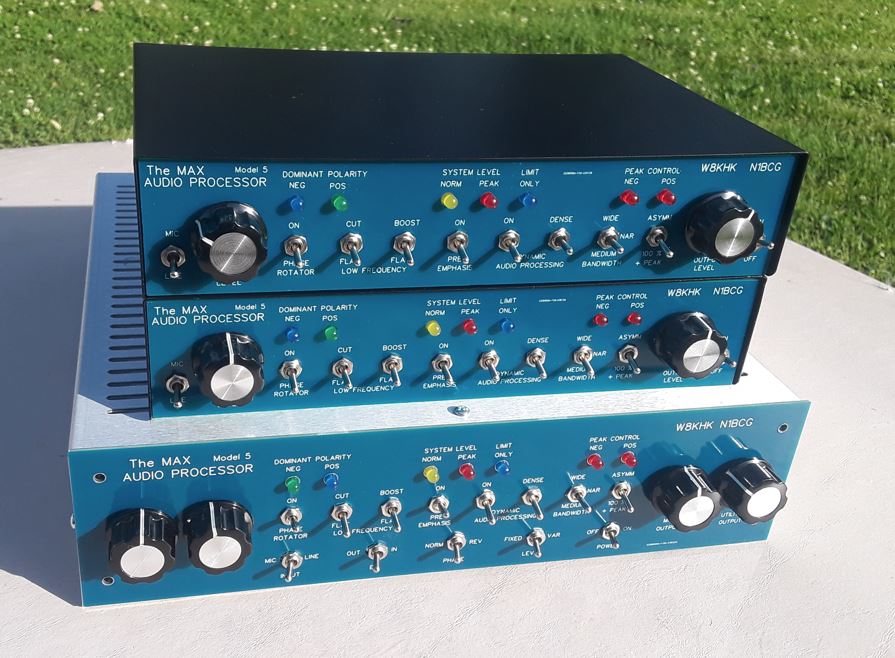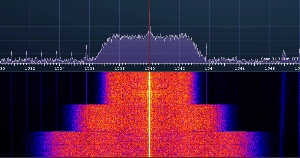|
MAX Audio Processor - Circuit Description
- Mic/Line Level Input - This versatile input uses an ultra-low noise
SSM2019 pre-amplifier and can be configured as either mic or line level and connected to either balanced or
unbalanced sources. Note that while microphones requiring “phantom” power may be used with the MAX Audio Processor, there is no 45 volt supply included in the design. An external phantom interface device is recommended in this
case.
- Line Level Input - An additional line input is provided to interface to other audio gear or receiver output for aircheck activities and can be connected to either balanced or unbalanced sources.
- Dominant Polarity Indicator - Two LEDs show the dominant polarity of
the source audio. The blue LED illuminates when the negative polarity is greater than the positive polarity.
Reversing the + and - connections to the balanced input would flip this so that the green LED would now be on more
of the time. These indicators typically alternate even with microphones "phased correctly" due to the complex nature
of speech waveforms. The All Pass Filter described below uses a proven circuit to address this phenomenon and cleanly maximize modulation.
- All Pass Filter/Phase Rotator - This function has been a part of
every broadcast audio processor since the 1980s due to its ability to increase average modulation levels without
changing gain. Compressors reduce gain based on the higher of either positive or negative peaks so asymmetrical
waveforms, common with speech, cause unnecessary gain reduction. By rotating the polarity of the incoming signal
throughout its frequency range, the overall waveform becomes more symmetric, resulting in less gain reduction
(louder audio). The circuit is referred to as an all pass filter because it is acoustically transparent unless
the speaker is wearing headphones. In this case, the effect can be heard since the path of audio to the ears
through the jaw and from the headphones will be neither in nor out of phase. Some detailed information is available here.
- Low Cut Filter - Also known as a "high pass filter" this circuit
attenuates frequencies below the communications vocal range. Background noise such as rumble or vibrations
from amplifier fans and power supplies are significantly reduced with this feaure enabled. It has the added
benefit of enhancing clarity when the MAX Audio Processor is set for narrow bandwidths by allowing the important
300-3000 Hz vocal range to be emphasized.
- Low Boost Filter - Some microphones attenuate lower vocal frequencies,
and while this is important for use in noisy locations such as when operating mobile, it can result in an
unnaturally
"tinny" sound in a quiet location. Turning on the Low Boost will help flatten the frequency response below 250 Hz
although this is not recommended when using narrow bandwidth settings.
- Pre-Emphasis - This active R/C circuit uses a 300uS time constant to
provide sufficient boost in the important vocal range. It is normally enabled to counteract the inherent loss of
higher frequencies by narrow bandwidth receivers and to improve the signal to noise ratio and intelligibility.
- NORM and PEAK Level Indicators - The MAX Audio Processor is designed
to accommodate source audio with a wide dymamic range as is typical of speech. The input level is optimized using a
setting that causes the yellow NORM LED to be on while talking while the red PEAK LED should only ocassionally
flicker. This is also the ideal level when using the Dynamic Processing feature described below.
- Dynamic Processing - Most common audio processors simply reduce gain at high input levels and increase gain at low input levels. This results in excessive background noise and the
"compressor breath" sound where inhaling between words is emphasized. Transmitting a signal with a low signal to
noise ratio reduces intelligibility, particulary when reception is poor.
The MAX Audio Processor offers a unique Dynamic Processing mode that applies the desired amount of compression
-only- when there is audio to be processed. This reduces background noise by preventing any increase in gain
when the input to the MAX processor drops below a preset level as indicated by the illumination of a blue LED.
At this point, the gain of the compressor "freezes", neither increasing or decreasing. This is very different from expanders or noise gates and provides a very natural transition from ambient audio to active audio to be optimized
for transmission.
- Compressor - The compressor section is designed to provide
effective transmitted audio control. User selectable settings range from a mellow "Open" sound for casual
conversations during good band conditions to a significantly aggressive "Dense" mode for challenging
conditions and contesting. Even this setting maintains enough dynamic range to preserve "sonic cues" that aid
in intelligibility.
Unlike off-the-shelf audio processors that use both the negative and positive half of the audio waveform to develop a gain reduction control voltage, the MAX Audio Processor uses just the negative half of the audio waveform. This ensures that the finite range of negative modulation is maximized by preventing asymmetric positive peaks from causing excessive gain reduction, an important characteristic of fully modulated AM. However, the circuitry for fullwave control is included and can be utilized for FM use with the addition of a single diode.
- SCAF Adjustable Bandwidth Filter - Bandwidth is controlled by two
MAX295 SCAF (Switched Capacitor Active Filter) chips wired in tandem. This arrangement provides a moderately steep
rolloff of frequencies above the set point while minimizing audible artifacts. The filter frequency is determined by
a three position switch, offering 3, 5, and 7 kHz frequency response (6, 10, and 14 kHz bandwidth). These frequencies
can be changed by the user for full customization.
- +/- Peak Controller - This circuit features separate limiters for the
positive and negative polarity peaks. Negative peak control is fixed while the positive peak control can be adjusted from symmetric (+100%) to asymmetric (around +130%). While this upper limit can be changed by the user, it has been
demonstrated that peak energy beyond +100% contributes nothing to perceived loudness yet there is an increased risk
of damage to modulation transformers and RF components due to exceeding component breakdown voltages.
A demonstration of modulating to +100% vs +150% using an Optimod 9200 can be seen here:
https://youtu.be/nVucVH0kNjc
With excessive peaks in check, average modulation levels can be increased noticably before reaching -100% (AM), triggering an ALC cutback (SSB), or reaching maximum deviation limits (FM). This peak controller circuit features
absolute -100% peak control and a user selectable +100% (all modes) or +125% (AM only) peak control.
- Line Level Output - The line-level output can be configured as either
balanced or unbalanced. A low-level connection for microphone inputs can be adjusted for proper level and polarity.
- Utility Output - This single-ended high-impedance output has both a fixed level around 0dBM and an adjustable level.
|





